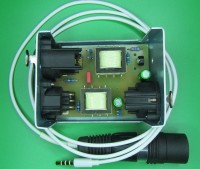Smartphone DI Box

This module is the perfect interface between a smartphone and a mixer
My passion for the DI box is not innoncent. Someone had given me a dictaphone to recover sound. No 3.5 jack, a small speaker with a horrible sound did not allow me to make a close take. So I opened the device and placed a transformer on the output of the small internal amp with crocodile clips. A surprise, a much better sound than that provided by the dictaphone. The problem
, it was the HP. So when you can get the signal from the source, do it !!!!!!!
Long before the arrival of the smartphone, I had already created an interface for a telephone handset (photo attached)
Some may say to themselves: why make this kind of device when there are already systems called RIG? I tell them that the RIG does not allow everything and that it must be chosen for the use to be made of it..Aware that other solutions are possible such as USB, the equipment will have to follow or the addition of a DAC will have to be considered. In my case, it's a fast Plug & Play that doesn't require any software modification.
It is clear that if you use your smartphone as a porta recorder, you will opt for USB but in our case, see it as a communication tool.
The module proposed here is the best compromise for managing the round trip of a communication via smartphone. The connection is professional with a Neutrik NCJ6 FAH Combo as input. This allows it to connect an XLR or a jack coming from the post auxiliary output (N-1) of the mixer. The signal is then reduced to conform to the micro level. The 4-point jack also collects L&R audio, mixing it to output on a 3P male XLR.
Everything is galvanically isolated and protected from direct voltages.
The input and output transformers were chosen to cover the HD Voice audio bandwidth (50Hz to 7 KHz).
Although having used the FC68125 connector from Cliff, it is possible to use others even pre-wired (FC68122C) in order to do a dubbing for the Apple system. See the inclued Pdf
Its use is extensive.
You are a DJ or radio host and wanted to involve your audience, this is the ideal low-cost TELCO tool to provide the link between your sound system or radio station. From the home studio to the reporter or boom operator in the field, he will be of great service to you..
With a slightly different layout, it can be converted into a “Walkie Talkie” interface in order to manage the “Radio Organization” concept. Talk Back signals from your console will be connected to it. (Talk back Send, Talk back return & Push to talk remote )
I have enclosed a wiring diagram for a Zoom style portable recorder. The reporter is recorded on the left or audio channel 1 and the correspondent on the right or audio channel 2. It is essential to follow the assignment of the Pan Pots as indicated..We are in the presence of 2 separate signals for ease of individual processing in post production.
Nowadays, there is really a craze for TRRS both at the PC level or all in one Poadcast. Here are more applications for my interface. Whether in a teleconference or broadcast office environment.
In the same spirit, if you are a MOJO fan (mobile journalist) and you want to manage incoming and outgoing sound, it is the interface that goes everywhere with its XLR connection, for example to connect your small portable mixer
If you have any doubts about your TRRS connection, see this link:
https://www.elektormagazine.fr/labs/trrs-checking
Many Android have joined the CTIA standard as Apple always has. We individuals are to follow.
For my part, I find that having the MIC signal on the Shield is not the right method. The DIY with metal TRRS jacks is to be excluded because you risk bringing interference to the MIC hot spot
Finally a last application, you use a TRS cable in the TRRS socket, you have a signal output DI BOX. It's the same as when you plug a classic headset into a smartphone.
You thus recover various signals such as walkman, portable cd, voice of GPS, Gameboy ... and are ready for old sound illustration.
For the transformers, I did with what I had in my drawers but it is possible for example to find in Monacor 2 transformers.
The LTR110 as 600/600 OUTPUT
The DIB 110 as INPUT, it is also used in the DI Boxes of the Monacor brand
The TY250P from Triad Magnetics can also be an alternative. (+/- 5€ )
If, for example, you want to use 2 same transformers for supply issues, the ideal is to insert a 20 dB pre-attenuator followed by the TX transformer and lastly a variable 20dB attenuator. The overall reduction can thus be 40 dB or a micro level..
In a rather communication-oriented range, the XICON brand offers low-cost transformers with various impedances.
The Teko packaging was simple with the use of a step drill for the Neutrik connectors:
https://www.teko.it/fr/produits/famille/AL/serie/al-box
A PCB using 2 identical Triad Transfos can be seen in the tips attached to the project.
If you have difficulty finding a TRRS socket, you still have the option of using a pre-wired model connected directly to the PCB:.https://www.audiophonics.fr/fr/jack-35mm/cordon-jack-35mm-4-poles-plaque-or-a-souder-60cm-p-8778.html
To conclude, the V1 is the one I made with what I had on hand.
The V2 uses 2 TRIAD broadband transformers.
The V3 uses 2 Bourns transformers for speech.
The V4 uses 2 XICON transformers for speech. They are easily found in 600/600 equivalents of other brands and at your supplier of electronic components.
The packaging can be considered with pre-machined products. Teko has many resources. For my part I recommend the metal case but if you take plastic, you can also glue metalized strip.
, it was the HP. So when you can get the signal from the source, do it !!!!!!!
Long before the arrival of the smartphone, I had already created an interface for a telephone handset (photo attached)
Some may say to themselves: why make this kind of device when there are already systems called RIG? I tell them that the RIG does not allow everything and that it must be chosen for the use to be made of it..Aware that other solutions are possible such as USB, the equipment will have to follow or the addition of a DAC will have to be considered. In my case, it's a fast Plug & Play that doesn't require any software modification.
It is clear that if you use your smartphone as a porta recorder, you will opt for USB but in our case, see it as a communication tool.
The module proposed here is the best compromise for managing the round trip of a communication via smartphone. The connection is professional with a Neutrik NCJ6 FAH Combo as input. This allows it to connect an XLR or a jack coming from the post auxiliary output (N-1) of the mixer. The signal is then reduced to conform to the micro level. The 4-point jack also collects L&R audio, mixing it to output on a 3P male XLR.
Everything is galvanically isolated and protected from direct voltages.
The input and output transformers were chosen to cover the HD Voice audio bandwidth (50Hz to 7 KHz).
Although having used the FC68125 connector from Cliff, it is possible to use others even pre-wired (FC68122C) in order to do a dubbing for the Apple system. See the inclued Pdf
Its use is extensive.
You are a DJ or radio host and wanted to involve your audience, this is the ideal low-cost TELCO tool to provide the link between your sound system or radio station. From the home studio to the reporter or boom operator in the field, he will be of great service to you..
With a slightly different layout, it can be converted into a “Walkie Talkie” interface in order to manage the “Radio Organization” concept. Talk Back signals from your console will be connected to it. (Talk back Send, Talk back return & Push to talk remote )
I have enclosed a wiring diagram for a Zoom style portable recorder. The reporter is recorded on the left or audio channel 1 and the correspondent on the right or audio channel 2. It is essential to follow the assignment of the Pan Pots as indicated..We are in the presence of 2 separate signals for ease of individual processing in post production.
Nowadays, there is really a craze for TRRS both at the PC level or all in one Poadcast. Here are more applications for my interface. Whether in a teleconference or broadcast office environment.
In the same spirit, if you are a MOJO fan (mobile journalist) and you want to manage incoming and outgoing sound, it is the interface that goes everywhere with its XLR connection, for example to connect your small portable mixer
If you have any doubts about your TRRS connection, see this link:
https://www.elektormagazine.fr/labs/trrs-checking
Many Android have joined the CTIA standard as Apple always has. We individuals are to follow.
For my part, I find that having the MIC signal on the Shield is not the right method. The DIY with metal TRRS jacks is to be excluded because you risk bringing interference to the MIC hot spot
Finally a last application, you use a TRS cable in the TRRS socket, you have a signal output DI BOX. It's the same as when you plug a classic headset into a smartphone.
You thus recover various signals such as walkman, portable cd, voice of GPS, Gameboy ... and are ready for old sound illustration.
For the transformers, I did with what I had in my drawers but it is possible for example to find in Monacor 2 transformers.
The LTR110 as 600/600 OUTPUT
The DIB 110 as INPUT, it is also used in the DI Boxes of the Monacor brand
The TY250P from Triad Magnetics can also be an alternative. (+/- 5€ )
If, for example, you want to use 2 same transformers for supply issues, the ideal is to insert a 20 dB pre-attenuator followed by the TX transformer and lastly a variable 20dB attenuator. The overall reduction can thus be 40 dB or a micro level..
In a rather communication-oriented range, the XICON brand offers low-cost transformers with various impedances.
The Teko packaging was simple with the use of a step drill for the Neutrik connectors:
https://www.teko.it/fr/produits/famille/AL/serie/al-box
A PCB using 2 identical Triad Transfos can be seen in the tips attached to the project.
If you have difficulty finding a TRRS socket, you still have the option of using a pre-wired model connected directly to the PCB:.https://www.audiophonics.fr/fr/jack-35mm/cordon-jack-35mm-4-poles-plaque-or-a-souder-60cm-p-8778.html
To conclude, the V1 is the one I made with what I had on hand.
The V2 uses 2 TRIAD broadband transformers.
The V3 uses 2 Bourns transformers for speech.
The V4 uses 2 XICON transformers for speech. They are easily found in 600/600 equivalents of other brands and at your supplier of electronic components.
The packaging can be considered with pre-machined products. Teko has many resources. For my part I recommend the metal case but if you take plastic, you can also glue metalized strip.






Updates from the author
ERRYSON 1 year ago
In a Hammond box, I placed a microphone preamp at THAT 1510 followed by a balanced output at THAT 1646.
The 3x2 monitoring allows me to listen to the microphone, the smartphone feedback, & possibly another IFB
An isolated DC/DC converter supplies symmetrical voltages of +/- 15V from a 12V battery.
The BUF634 headphone amp is the one I published on Elektor Labs.
test-20240418213633.JPG (307kb)
J.F. Simon, Elektor 11 months ago
ERRYSON 11 months ago
alim-12v.JPG (154kb)
connectique-laterale.JPG (222kb)
ERRYSON 1 year ago
ERRYSON 1 year ago
https://www.audiophonics.fr/fr/connectors-usb/ataudio-connector-usb-c-male-plaque-rhodium-dac-alc5686-p-17764.html
ERRYSON 1 year ago
ERRYSON 2 years ago
ERRYSON 3 years ago
ERRYSON 3 years ago
ERRYSON 3 years ago
Having used Neutrik sockets for In & Out, I just made a version replacing the 4-point Jack or Tiny Rean TA5 with an NC5FBH.
RT5MP-D.pdf (47kb)
module-with-nc5fbh.JPG (125kb)
ERRYSON 4 years ago
A new V2 PCB using 2 Triad Transfos has just been made.
It will certainly be easier for ordering components.
The TRRS Jack has been wired to the CTIA standard. My first version was in OMTP.
Compared to the basic project V1, the V2 is based on the use of 2 Triad broadband transformers. The V3 uses Bourns LM-Np-1000 series cataloged "speech" transformers. The V2 & V3 PCBs are included in the appendix of the project.
LM- NP- 1001, 1002,1003, 1004 can easily be placed in place of 1005.
pcb-v3-with-lm-np-bourns.JPG (578kb)